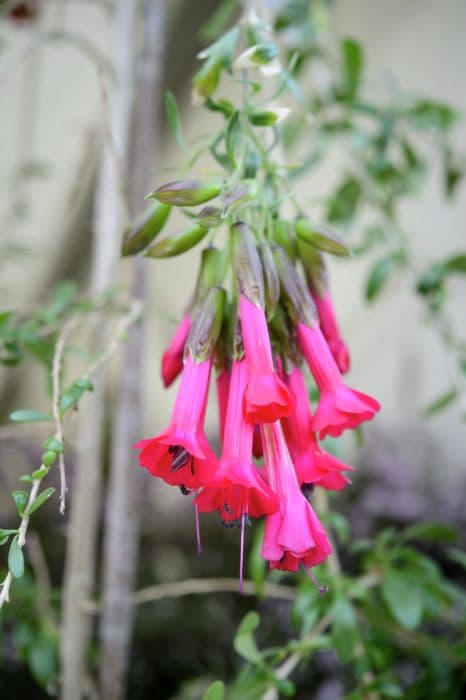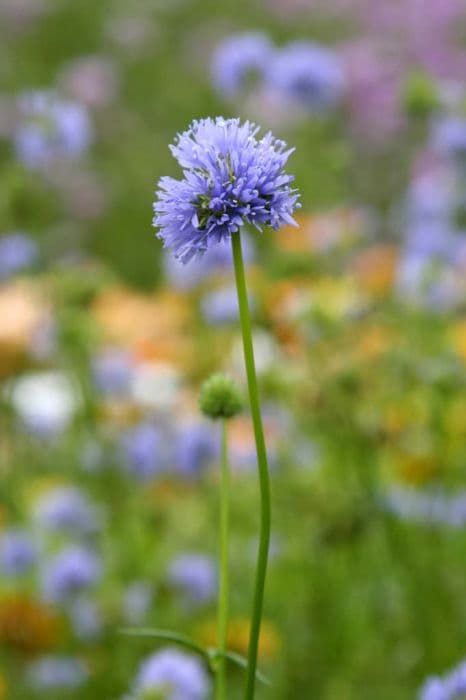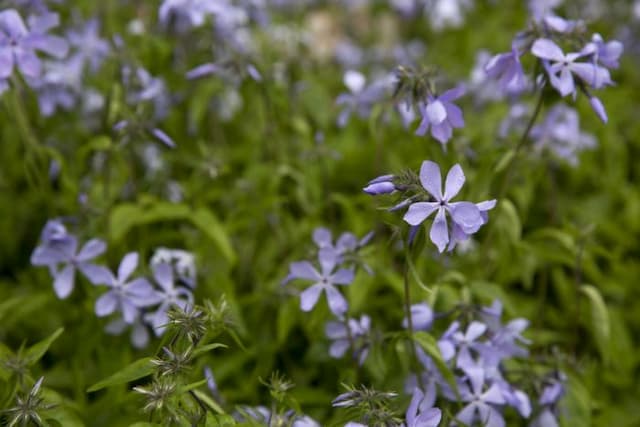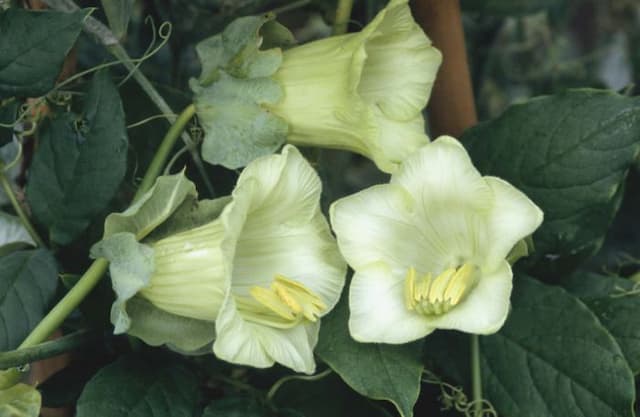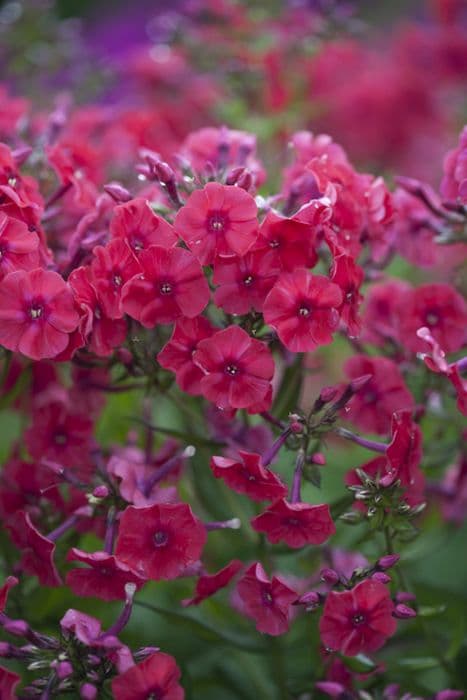Woodland Phlox Phlox divaricata 'White Perfume'

ABOUT
The plant known as 'White Perfume' is a cultivar of woodland phlox, recognized for its fragrant, star-shaped white flowers. The blooms cluster at the tips of stems, creating a dense and showy display that can add an airy, ethereal quality to gardens. The flowers exude a sweet scent that is particularly noticeable in the evening or early morning. Foliage of this plant is an attractive shade of green and takes on a low-growing, mat-forming habit, which helps it contribute to a lush groundcover during the blooming season. The leaves are lance-shaped, providing a delicate texture that complements the flowers. This plant typically flowers in spring and can continue into early summer, offering a long period of visual and olfactory interest. It is a popular choice for planting in areas such as woodland gardens, shaded borders, and naturalized areas where its characteristic white flowers can brighten up the shade.
About this plant
 Names
NamesFamily
Polemoniaceae
Synonyms
Woodland Phlox, Wild Blue Phlox, Wild Sweet William, Louisiana Phlox
Common names
Phlox divaricata 'White Perfume'
 Characteristics
CharacteristicsLife cycle
Perennials
Foliage type
Deciduous
Color of leaves
Green
Flower color
White
Height
1 feet 2 inches (35.56 cm)
Spread
1 feet 2 inches (35.56 cm)
Plant type
Herb
Hardiness zones
3
Native area
North America
Benefits
 General Benefits
General Benefits- Attracts Pollinators: Phlox divaricata 'White Perfume' attracts bees, butterflies, and other beneficial insects, helping to pollinate the garden.
- Low Maintenance: This plant is relatively easy to care for, requiring minimal upkeep once established in suitable conditions.
- Aesthetic Appeal: With its white flowers and pleasant fragrance, it adds visual beauty and scent to garden landscapes.
- Erosion Control: The plant's dense growth habit can help stabilize soil and prevent erosion in garden settings.
- Drought Tolerance: Once established, it exhibits good drought tolerance making it suitable for xeriscaping or in areas with water restrictions.
- Wildlife Friendly: It provides nectar for pollinators and can be a habitat for small wildlife, contributing to biodiversity.
- Seasonal Interest: Blooming in spring, it adds seasonal interest to the garden with its flowers.
- Ground Cover: Its spreading habit makes it an effective ground cover, suppressing weeds and covering bare spots in the landscape.
- Compatibility: It combines well with other perennials, allowing for diverse and attractive planting designs.
- Non-Invasive: Unlike some other species, it does not typically spread uncontrollably, reducing the need for frequent management.
 Medical Properties
Medical PropertiesThis plant is not used for medical purposes.
 Air-purifying Qualities
Air-purifying QualitiesThis plant is not specifically known for air purifying qualities.
 Other Uses
Other Uses- As a natural dye: The flowers of wood phlox can be used to create a gentle, soothing dye for fabrics or paper, giving them a light violet hue.
- Photography backdrops: Due to its lush foliage and delicate white flowers, wood phlox serves as a picturesque backdrop for nature photography and macro shots.
- Edible flower garnishes: While not commonly consumed, the flowers of wood phlox can be used as decorative, edible additions to salads or desserts, assuming they're pesticide-free.
- Fairy gardens: Wood phlox is an ideal plant for creating a whimsical, fairy garden setting due to its low growth habit and enchanting flowers.
- Candle making: The petals of wood phlox can be embedded in wax to create floral-patterned candles that are decorative and subtly fragrant when unscented.
- Potpourri ingredient: The fragrant blooms of wood phlox, once dried, can be incorporated into potpourri mixes to add a natural, woodland scent to a room.
- Art supplies: Pressed flowers of wood phlox can be used in art projects, such as resin jewelry, bookmarks, or in creating botanical prints.
- Horticultural therapy: Wood phlox, with its gentle appearance and ease of care, may be used in therapeutic gardens or programs to provide a calming environment and foster horticultural learning.
- Bath additives: Fresh or dried wood phlox flowers can be added to bathwater for a fragrant, flower-strewn spa experience at home.
- Floral ice cubes: Freeze small wood phlox flowers in ice cubes to create decorative, charming additions to summertime beverages for special occasions.
Interesting Facts
 Feng Shui
Feng ShuiWoodland Phlox is not used in Feng Shui practice.
 Zodiac Sign Compitability
Zodiac Sign CompitabilityWoodland Phlox is not used in astrology practice.
 Plant Symbolism
Plant Symbolism- Harmony: Phlox divaricata 'White Perfume', commonly known as Wild Blue Phlox, often signifies harmony due to its clustered flowers that grow together in unity, suggesting a sense of peaceful coexistence.
- Agreement: The way the blossoms of the Wild Blue Phlox fit together can also represent agreement, as they symbolize different elements coming together to create balance and beauty.
- Sweet Dreams: Due to its pleasant fragrance, Wild Blue Phlox is sometimes associated with sweet dreams, signifying tranquil sleep and peaceful nighttime thoughts.
- Proposal: The flower's gentle appearance and inviting scent make it a representation of a proposal or an offer, often related to love or friendship.
 Water
WaterWoodland Phlox requires even moisture and should be watered deeply about once a week, depending on the weather conditions. An inch of water weekly is usually recommended, which equates to approximately 0.6 gallons for a small to medium-sized plant. During particularly dry periods, you may need to water more frequently, ensuring the soil remains moist but not soggy. It's essential to avoid overhead watering to prevent disease, and instead water at the soil level.
 Light
LightWoodland Phlox thrives in dappled sunlight or in an area with morning sun and afternoon shade. This plant is best situated in a location that mimics its natural woodland habitat, so avoid placing it in full, harsh afternoon sunlight as it may lead to leaf scorch.
 Temperature
TemperatureWoodland Phlox prefers temperatures between 60°F and 80°F but can survive minimum temperatures down to 20°F and maximum temperatures up to 90°F. The plant's ideal growing conditions are cool, temperate climates, as extreme heat can cause stress and wilting.
 Pruning
PruningWoodland Phlox should be pruned to encourage bushier growth and to remove any spent flowers, which will promote further blooming. Pruning is best done after the plant has finished flowering, typically in late spring or early summer. Deadheading the spent blooms regularly can also be beneficial.
 Cleaning
CleaningAs needed
 Soil
SoilWoodland Phlox requires rich, moist, well-draining soil with a pH of 5.8 to 6.8. An ideal soil mix can be made by combining two parts garden soil, one part peat moss or well-rotted compost, and one part perlite or coarse sand to ensure proper drainage and aeration.
 Repotting
RepottingWoodland Phlox typically does not require frequent repotting and can often be left undisturbed for several years. However, if it outgrows its space or the soil becomes exhausted, it should be repotted in the spring or early fall.
 Humidity & Misting
Humidity & MistingWoodland Phlox thrives best in environments with average to high humidity levels. It is not particularly demanding but prefers conditions that mimic its native woodland habitat, which tend to be more humid than arid.
 Suitable locations
Suitable locationsIndoor
Use bright, indirect light and moist, well-draining soil.
Outdoor
Plant in partial shade. Maintain moist soil and mulch.
Hardiness zone
3-8 USDA
 Life cycle
Life cyclePhlox divaricata 'White Perfume', commonly known as White Perfume woodland phlox, begins its life cycle when seeds are sown in the soil, typically requiring a period of cold stratification to break dormancy. Germination occurs in early spring, and seedlings emerge, developing into rosettes of green foliage. In its vegetative stage, through spring and summer, the plant grows and establishes itself, with roots spreading in the soil. The mature perennial enters its reproductive stage, producing fragrant, white flowers in late spring to early summer, attracting pollinators for fertilization. Following pollination, the flowers develop into seed capsules which eventually dry and release seeds, completing its reproductive cycle. During autumn, the above-ground part of the plant begins to die back as it enters dormancy for the winter, with the root system remaining alive underground to sprout again the next spring.
 Propogation
PropogationPropogation time
Spring to Summer
The most popular method of propagating Phlox divaricata 'White Perfume', commonly known as Woodland Phlox or Wild Sweet William, is through division. This is typically carried out in the early spring or late summer. To propagate by division, carefully dig up an established clump and gently separate the root mass into smaller sections using a garden fork or spade. Each section should have several shoots and a portion of the root system. Afterwards, the divisions should be replanted at the same depth they were originally growing, spaced about 12 to 15 inches (approximately 30 to 38 centimeters) apart to allow for adequate air circulation and growth. The soil should be kept moist until the new divisions are well established.
